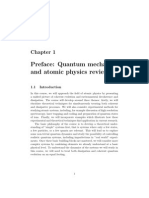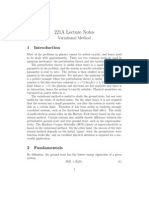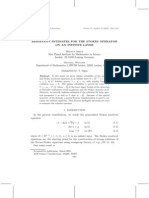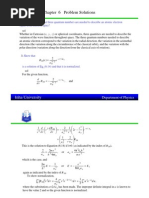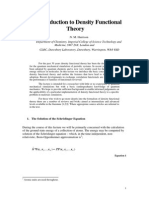Finite Element Methods
Uploaded by
Ashaju Abimbola SamuelFinite Element Methods
Uploaded by
Ashaju Abimbola SamuelLecture #10
Plan:
1. Variational method
2. Rayleigh-Ritz trial functions
3. Derivation of the secular equation
4. H2+ ion full problem and associated challenges
5. Born-Oppenheimer approximation the electronic Hamiltonian
6. Solving the secular equation for the H2+ molecule
Questions you should be able to answer by the end of todays lecture:
1. Understand the idea behind the variational method for approximating
eigenfunctions.
2. Why does bonding occur?
3. How to calculate simple approximations to the molecular orbital in an ionized
Hydrogen molecule.
4. How do the molecular orbitals change as the interatomic distance is decreased
5. What physical insight leads to the separation of the electronic and nuclear
coordinates?
6. How to choose trial wave functions and use the variation principle.
References:
1. Merzbacher chapter 8.
2. Lowe, chapter 7.
3. Dahl Chapter 12 and 13.
The variation method
The problem: in most cases of physical interest the eigenfunctions of the Hamiltonian
cannot be readily found. In such cases one needs to resort to a systematic procedure for
searching for functions which approximate the eigenfunctions. The calculus of variations
provides us with a powerful tool for solving such problems where H is known but not
n
u and
n
E .
The variation method is based on the idea that if we try to find a trial function that
minimizes average E it will be greater or equal than the true ground state eigenfunctions
n
u .
-
-
v
ground state
H d
E H E
d
Proof:
Because H is Hermitian its true eigenfunctions are a complete set therefore any function
and in particular the trial function can be expanded in terms of eigenfunctions:
( ) ( )
1
n
n n
i
x c u x
2
1
n
n n
i
H c E
and
2
1
n
n
i
c
For
ground
E H E it is necessary and sufficient for all 0
n
c except for n=1.
Note: it is possible to find eigenvalues other than the ground energy using the variation
method:
The Rayleigh Ritz trial function
In this method a trial function is chosen as a linear combination of independent and - in
most cases orthogonal and normalized - basis functions . Thus the trial function is of
the form:
1
N
n n
n
c
The trial function can be viewed as a vector in a basis of where the cs are the
components of the vector.
The expectation value is expressed as,
, 1
, 1
N
i i j j
i j
N
i j
i j
c H c
H
H
c c
note: the expression
i j
H is a complex number obtained by performing the integral
i j
H dv
and is called the i,j matrix element of H or
ij
H .
The condition for achieving a stationary (or minimum) value of H with respect to
variations in the trial wavefunction is:
0
i
H
c
and
0
j
H
c
1 , 1 , 1
2
, 1
1 , 1 , 1
, 1
1
, 1
0
N N N
i j j i j i i i j j
j i j i j
N
i
i j
i j
N N N
i j j i j i i i j j
j i j i j
N
i i j j
N
i j
i j j i i i
N
j
i j
i j
H c c c c c H c
H
c
c c
H c c c c c H c
c H c
H c c H c Ec
c c
_
,
_
,
_
,
Yielding n equations with n unknowns since for each ci there is a separate equation, E
being the expectation value corresponding to the optimal choice of the trial function. This
equation is known as the secular equation and we are looking for its roots (i.e the E
values).
( )
1
0
n
i j ij j
j
H E c
in matrix notation,
1 11 12 1
2 21 22
1
....
0
n
n n nn
c H E H H
c H H E
c H H E
1 _
1
1
1
1
, ]
M M
which can only have a non-trivial solution if
( )
1
0
n
i j ij
j
Det H E
_
,
For a case of a set of basis functions which are not orthogonal or normalized, the secular
determinant becomes:
11 11 12 12 1 1
21 21 22 22
1 1
....
0
n n
n n nn nn
H S E H S E H S E
H S E H S E
H S E H S E
M
where the matrix elements are defined in the following way:
ij i j
ij i j
H H dv
S dv
Thus the problem of finding the approximate eigenfunctions and corresponding energy
spectrum has been transformed from one that involves functions and minimization to an
algebraic problem.
The Ritz Theorem: The expectation value of the Hamiltonian is stationary in the vicinity
of its discrete eigenvalues.
All of the intelligence goes into choosing a good trial function, which already contains
in it a large amount of the true eigenfunction. The trial function is chosen with the aid of
physical insight. Hartree Fock method for calculating eigenfunctions of many electron
Hamiltonians is also an example of the variation method.
Understanding the chemical bond - Approximating the wave functions of molecules
LCAO linear combination of atomic orbitals
The problem:
How do we calculate the eigenfunctions of molecules?
The system simple diatomic molecule
I] Draw the potential
R
2
r
1
r
A
B
II] Write the full Hamiltonian
( )
{
2 2 2 2 2 2
2 2 2
1 2
nuclear repulsion
electron-nucleus of electron
energy
attraction
, , , , ,
2 2 2
A B A B r A B
e p p
KE
e e e
H R R r P P p
m m m r r R
_
+ +
,
r r r
h h h
14243 14243
where,
1
2
A
B
r r R
r r R
r
r r
r
r r
In general the wave functions should contain all of the coordinates of the system
Because the protons are 1836 times heavier than the electrons they have much smaller
velocity this means that at the time scales associated with the electronic movement the
protons are stationary.
The Born-Oppenheimer Approximation
Based on the observation that the mass of the proton is approximately 1836 heavier than
the mass of the electron. We assume that due to this mass disparity there is a response
time scale difference between the slow nuclei and the fast electron. We assume that the
motion of the nucleus is adiabatic (i.e. infinitely slow).
(1) The electronic wavefunctions depend only on the positions of the nuclei and not
on their momentum
(2) The positions of the protons are a parameter not a QM variable
(3) Protons have a fixed separation R just add a constant to the energy.
(4) Reduce the three body problem to an electron in a potential
(5) The Hamiltonian is separable
Using the procedure we developed:
Write the Hamiltonian for the electron energy and nuclear repulsion energy.
el
2 2 2 2
2
1 2
H
2
el nr r
e
electronic energy
e e e
H
m r r R
+
r
h
144424443
( ) ( )
2
/
elec elec elec elec
elec nuc nuc rep elec
H u r E u r
E E E e R
+ +
What we have is a functional dependence of the electronic energy on the nuclear
separation ( )
elec
E R .
( ) ( )
{
2 2 2
2 2
nuclear repulsion
energy
,
2 2
A B A B elec
p p
e
H R R E R
m m R
_
+ + +
,
r r
h h
( ) ( ) ( )
, , ,
nuc A B nuc A B nuc nuc A B
H R R u R R E u R R
These eigenfunction reperesent the translation, rotation and vibration states of the crystal.
( ) ( ) ( ) , , ,
Tot A B elec nuc A B
u R R r u r u R R
We would like the find the exact energy eigenfunctions because this is difficult we will
find approximate solutions
el
H u Eu
Assume that our solution can be written as a linear combination of atomic orbitals
( ) ( ) ( )
( )
1 2
0
1 100 1 2 100 2
100 1
1
2
1
r
a
A
B
r c u r c u r
u r e
where
r r R
r r R
r r r
123 14243
r
r
r r
r
r r
The justification for this choice is that when the atoms are infinitely far apart (separated
atom limit) the eigenfunctions should be the exact hydrogen atom functions.
Since this wave function is not an energy eigenfunction we would like to minimize the
average energy or the expectation value with respect to the coefficients,
-
-
v
av
H d
E H
d
( )
( ) ( ) ( ) ( ) ( )
( ) ( )
( )
( ) ( ) ( )
1 2
1 100 1 2 100 2 1 100 1 2 100 2
1 2
1 100 1 2 100 2 1 100 1 2 100 2
,
c u r c u r H c u r c u r dv
E c c
c u r c u r c u r c u r dv
_
+ +
,
+ +
r r r r
123 14243
r r r r
We are now going to apply the variation principle to allow us to find the function
which minimizes E (Cauchy Reiman Theorem).
0
i
E
c
Minimizing the energy expectation value with respect to the coefficients leads us to
the determinant problem,
( ) ( )
( ) ( )
11 11 1 12 12 2
21 21 1 22 22 2
0
0
H ES c H ES c
H ES c H ES c
+
+
11 12 1 11 12 1
21 22 2 21 22 2
11 11 12 12
21 21 22 22
11 12
+
12
11 12
-
12
0
1
E
1 1
1
E
1 1
H H c S S c
E
H H c S S c
H ES H ES
H ES H ES
H H
S
H H
S
1 _ 1 _
1 1
] , ] ,
_ +
+
,
_
,
We get two solutions for the approximate eigenfunctions, where we have used the
normalization condition
( ) ( ) ( ) ( ) ( ) ( ) ( )
12
2 2 2
2 2
1 100 1 2 100 2 1 100 1 2 100 2 1 2 100 1 100 2
1 1
2 2
1 2 1 2
1
2
2 1
S S
dv
c u r c u r dv c u r dv c u r dv c c u r u r dv
c c c c
+ + +
+ +
14243 14243 144424443
which leads to the normalization coefficients for the two approximate eigenfunctions
( )
( )
( ) ( ) ( )
( )
( )
( ) ( ) ( )
100 1 100 2
100 1 100 2
1
2 1
1
2 1
r u r u r
S
r u r u r
S
E E
+
+
<
r r r
r r r
Take a closer look at the integrals,
Get a number of integrals which we will label in the following way:
( ) ( )
( ) ( )
( ) ( )
( ) ( )
( ) ( )
( ) ( )
( )
( ) ( )
( )
100 1 100 1 11
100 2 100 2 22
100 1 100 2 12
100 2 100 1 21
100 1 100 1 11
100
100 2 100 2 22
100 1 100 2 12
100 2 10
1
since is orthonormal
1
i
u r Hu r dr H
u r Hu r dr H
u r Hu r dr H
u r Hu r dr H
u r u r dr S
u r
u r u r S
u r u r dr S
u r u
r r
r r
r r
r r
r r
r
r r
r r
r
( )
( ) ( )
100 100
0 1 21
0 overlap integral are non-orthogonal
i j
u r u r
r dr S
r r
r
The coulomb energy integral:
( ) ( )
( ) ( ) ( ) ( )
1
100 1 100 1 11 22
2 2 2
2
100 1 100 1 100 1 100 1
1 2
2
E coulomb integral
u r Hu r dr H H
e e
u r u r dr u r u r dr
m r r
_ _
, ,
r r
h r r r r
144444424444443 14444244443
The second term in the coulomb integral describes the attractive electrostatic
interaction between the proton B and the electron around proton A tends to lower the
energy.
The resonance energy contribution:
( ) ( )
( ) ( ) ( ) ( )
1
100 1 100 2 12 21
2 2 2
2
100 1 100 2 100 1 100 2
2 1
2
E S resonant integral
u r Hu r dr H H
e e
u r u r dr u r u r dr
m r r
_ _
, ,
r r
h r r r r
144444424444443 14444244443
The interaction leads to the splitting and the creation of two energy levels
The overlap integral tends to destabilize the molecule.
H atom energy
11
H
11 12
H H +
11 12
H H
11 12
12
1
H H
E
S
2
e
E
R
+
2
e
E
R
+
+
11 12
12
1
H H
E
S
+
+
+
E
n
e
r
g
y
(
a
.
u
=
2
7
.
2
1
e
V
)
1
2
1
1.7
Consequences:
1. Odd and even wave functions the odd wavefunction has a node which is located
between the two nucluei.
2. Draw the wavefunction evaluated along the internuclear separation line.
3. Splitting of the energy levels as the internuclear spacing decreases.
4. The total energy of the molecule (including the proton-proton) repulsion.
R
E
e
l
R
E
t
Ro R
E
t
Ro
bonding
anti
bonding
5. The lower electron eigenfunction or state has a corresponding minimum in the
total energy while the higher energy electon state rise monotonically.
6. The internuclear distance at which the system acheives a minimum is the bond
length which is 2
0
R
7. The energy minimum in the lower curve indicates a stable molecule and the
corresponding MO is call bonding MO. The other MO is called antibonding.
8. The electron in the bonding state will have a wavefunction that leads to a high
probability of finding the electron in between the nuclei this allows for the
attractive e-p forces to offset the repulsive p-p interactions.
9. Near the minimum energy,
( )
2
0
2
K
E R R ;
K is the bond stiffness.
10. In diatomic MO we distinguished between and type bonds. What is the
significance of this labeling scheme? Recall that the AO were labeled with s, p, d
labels which were associated with the orbital angular momentum and the
spherically symmetric potential. Since L^2 commuted with the Hamiltonian we
could find a basis set which was common to
2
,
z
L L and the Hamiltonian. In a
linear molecule the rotational symmetry around the z axis is conserved hence
there is a conservation of the
z
L component of the angular momentum that is why
the MO are labeled according to their symmetries.
The angular solutions
You might also like
- OU Open University SM358 2007 Exam SolutionsNo ratings yetOU Open University SM358 2007 Exam Solutions23 pages
- An Introduction To Computational Chemistry LaboratoryNo ratings yetAn Introduction To Computational Chemistry Laboratory39 pages
- Brief Review of Quantum Mechanics (QM) : Fig 1. Spherical Coordinate SystemNo ratings yetBrief Review of Quantum Mechanics (QM) : Fig 1. Spherical Coordinate System6 pages
- Introduction To Computational Chemistry: Andrew S. IchimuraNo ratings yetIntroduction To Computational Chemistry: Andrew S. Ichimura30 pages
- Helium Atom, Approximate Methods: 22nd April 2008No ratings yetHelium Atom, Approximate Methods: 22nd April 200817 pages
- P2214 Homework 14 Solutions - Spring 2011No ratings yetP2214 Homework 14 Solutions - Spring 20117 pages
- Lecture 8: Variational Method: The Helium Atom (10/13/2005) : A Few Comments On Chaotic SystemsNo ratings yetLecture 8: Variational Method: The Helium Atom (10/13/2005) : A Few Comments On Chaotic Systems8 pages
- 2.57 Nano-to-Macro Transport Processes Fall 2004No ratings yet2.57 Nano-to-Macro Transport Processes Fall 20047 pages
- Damped Harmonic Oscillator: Wednesday, 23 October 2013No ratings yetDamped Harmonic Oscillator: Wednesday, 23 October 20139 pages
- Surface Physics Exercises in Quantum Mechanics by D.H. WhittumNo ratings yetSurface Physics Exercises in Quantum Mechanics by D.H. Whittum17 pages
- Approximation Methods For Stationary States: 7.1 Time-Independent Perturbation TheoryNo ratings yetApproximation Methods For Stationary States: 7.1 Time-Independent Perturbation Theory16 pages
- Chapter1-Physical Principles of Quantum MechanicsNo ratings yetChapter1-Physical Principles of Quantum Mechanics12 pages
- 17.4 A Worked Example: Spheroidal Harmonics: "Algebraically Difficult" Sets of Differential EquationsNo ratings yet17.4 A Worked Example: Spheroidal Harmonics: "Algebraically Difficult" Sets of Differential Equations12 pages
- 10 Self-consistent field theory: ² ψ − ∇ ψ dr - ψ - r − r - ψ δ dr ψ - r − r - ψNo ratings yet10 Self-consistent field theory: ² ψ − ∇ ψ dr - ψ - r − r - ψ δ dr ψ - r − r - ψ4 pages
- Energy Loss of A High Charge Bunched Electron Beam in PlasmaNo ratings yetEnergy Loss of A High Charge Bunched Electron Beam in Plasma13 pages
- Potential Energy Surfaces: School of Chemistry and Biochemistry Georgia Institute of TechnologyNo ratings yetPotential Energy Surfaces: School of Chemistry and Biochemistry Georgia Institute of Technology17 pages
- CHAPTER 10: Atomic Structure and Atomic SpectraNo ratings yetCHAPTER 10: Atomic Structure and Atomic Spectra25 pages
- CE603: Partial Differential Equations (Instructor's Scribble) Expected OutcomeNo ratings yetCE603: Partial Differential Equations (Instructor's Scribble) Expected Outcome12 pages
- Effective Action and Renormalization Group Flow of Anisotropic SuperconductorsNo ratings yetEffective Action and Renormalization Group Flow of Anisotropic Superconductors19 pages
- Introduction To The Theory of Pseudopotentials: Patrick BriddonNo ratings yetIntroduction To The Theory of Pseudopotentials: Patrick Briddon43 pages
- Helium Atom, Approximate Methods: 24th April 2008No ratings yetHelium Atom, Approximate Methods: 24th April 200823 pages
- Resolvent Estimates For The Stokes Operator On An Infinite LayerNo ratings yetResolvent Estimates For The Stokes Operator On An Infinite Layer30 pages
- Coupled Cluster Theory: Analytic Derivatives, Molecular Properties, and Response TheoryNo ratings yetCoupled Cluster Theory: Analytic Derivatives, Molecular Properties, and Response Theory31 pages
- Extension of Group Theory To Reactors of Finite Size: 22.05 Reactor Physics - Part NineteenNo ratings yetExtension of Group Theory To Reactors of Finite Size: 22.05 Reactor Physics - Part Nineteen9 pages
- Residual-Based A Posteriori Estimators For The A/phi Magnetodynamic Harmonic Formulation of The Maxwell SystemNo ratings yetResidual-Based A Posteriori Estimators For The A/phi Magnetodynamic Harmonic Formulation of The Maxwell System32 pages
- Solution of Exercise 1: FY8201 / TFY8 Nanoparticle and Polymer Physics INo ratings yetSolution of Exercise 1: FY8201 / TFY8 Nanoparticle and Polymer Physics I3 pages
- Atomic Units Molecular Hamiltonian Born-Oppenheimer ApproximationNo ratings yetAtomic Units Molecular Hamiltonian Born-Oppenheimer Approximation7 pages
- Hartree-Fock Theory: Erin Dahlke Department of Chemistry University of Minnesota Vlab Tutorial May 25, 2006No ratings yetHartree-Fock Theory: Erin Dahlke Department of Chemistry University of Minnesota Vlab Tutorial May 25, 200642 pages
- The Dirac Equation: Proc. R. Soc. Lond. A 117, 610-624 (1928)No ratings yetThe Dirac Equation: Proc. R. Soc. Lond. A 117, 610-624 (1928)9 pages
- Computational Neural Networks Driving Complex Analytical Problem SolvingNo ratings yetComputational Neural Networks Driving Complex Analytical Problem Solving7 pages
- Phylogenetics and Morphological Evolution of Euphorbia Subgenus EuphorbiaNo ratings yetPhylogenetics and Morphological Evolution of Euphorbia Subgenus Euphorbia182 pages
- Transport Processes & Separation Process Principles (Includes Unit Operations) Christie John Geankoplis Fourth Edition0% (1)Transport Processes & Separation Process Principles (Includes Unit Operations) Christie John Geankoplis Fourth Edition7 pages
- Double-Species Slurry Flow in A Horizontal Pipeline: P. V. Skudarnov C. X. Lin M. A. EbadianNo ratings yetDouble-Species Slurry Flow in A Horizontal Pipeline: P. V. Skudarnov C. X. Lin M. A. Ebadian8 pages
- Math 372: Fall 2015: Solutions To Homework: Steven Miller December 7, 2015No ratings yetMath 372: Fall 2015: Solutions To Homework: Steven Miller December 7, 201551 pages
- 03 - TS - CH-3 Polynomials - Sa-1 Booklet - 2023-2024No ratings yet03 - TS - CH-3 Polynomials - Sa-1 Booklet - 2023-20249 pages
- RD-Sharma-Solution-Class-9-Maths-Chapter-23-Graphical-Representation-of-Statistical-Data-Exercise-23.3No ratings yetRD-Sharma-Solution-Class-9-Maths-Chapter-23-Graphical-Representation-of-Statistical-Data-Exercise-23.34 pages
- The Bounded Convergence Theorem - Brian ThomsonNo ratings yetThe Bounded Convergence Theorem - Brian Thomson22 pages
- 1.write A Program To Print ' 100 Times Using Linefeed and Carriage Return. CodeNo ratings yet1.write A Program To Print ' 100 Times Using Linefeed and Carriage Return. Code7 pages
- Solutions of Linear Equation and Inequality in One VariableNo ratings yetSolutions of Linear Equation and Inequality in One Variable6 pages
- An Introduction To Computational Chemistry LaboratoryAn Introduction To Computational Chemistry Laboratory
- Brief Review of Quantum Mechanics (QM) : Fig 1. Spherical Coordinate SystemBrief Review of Quantum Mechanics (QM) : Fig 1. Spherical Coordinate System
- Introduction To Computational Chemistry: Andrew S. IchimuraIntroduction To Computational Chemistry: Andrew S. Ichimura
- Lecture 8: Variational Method: The Helium Atom (10/13/2005) : A Few Comments On Chaotic SystemsLecture 8: Variational Method: The Helium Atom (10/13/2005) : A Few Comments On Chaotic Systems
- Damped Harmonic Oscillator: Wednesday, 23 October 2013Damped Harmonic Oscillator: Wednesday, 23 October 2013
- Surface Physics Exercises in Quantum Mechanics by D.H. WhittumSurface Physics Exercises in Quantum Mechanics by D.H. Whittum
- Approximation Methods For Stationary States: 7.1 Time-Independent Perturbation TheoryApproximation Methods For Stationary States: 7.1 Time-Independent Perturbation Theory
- 17.4 A Worked Example: Spheroidal Harmonics: "Algebraically Difficult" Sets of Differential Equations17.4 A Worked Example: Spheroidal Harmonics: "Algebraically Difficult" Sets of Differential Equations
- 10 Self-consistent field theory: ² ψ − ∇ ψ dr - ψ - r − r - ψ δ dr ψ - r − r - ψ10 Self-consistent field theory: ² ψ − ∇ ψ dr - ψ - r − r - ψ δ dr ψ - r − r - ψ
- Energy Loss of A High Charge Bunched Electron Beam in PlasmaEnergy Loss of A High Charge Bunched Electron Beam in Plasma
- Potential Energy Surfaces: School of Chemistry and Biochemistry Georgia Institute of TechnologyPotential Energy Surfaces: School of Chemistry and Biochemistry Georgia Institute of Technology
- CE603: Partial Differential Equations (Instructor's Scribble) Expected OutcomeCE603: Partial Differential Equations (Instructor's Scribble) Expected Outcome
- Effective Action and Renormalization Group Flow of Anisotropic SuperconductorsEffective Action and Renormalization Group Flow of Anisotropic Superconductors
- Introduction To The Theory of Pseudopotentials: Patrick BriddonIntroduction To The Theory of Pseudopotentials: Patrick Briddon
- Resolvent Estimates For The Stokes Operator On An Infinite LayerResolvent Estimates For The Stokes Operator On An Infinite Layer
- Coupled Cluster Theory: Analytic Derivatives, Molecular Properties, and Response TheoryCoupled Cluster Theory: Analytic Derivatives, Molecular Properties, and Response Theory
- Extension of Group Theory To Reactors of Finite Size: 22.05 Reactor Physics - Part NineteenExtension of Group Theory To Reactors of Finite Size: 22.05 Reactor Physics - Part Nineteen
- Residual-Based A Posteriori Estimators For The A/phi Magnetodynamic Harmonic Formulation of The Maxwell SystemResidual-Based A Posteriori Estimators For The A/phi Magnetodynamic Harmonic Formulation of The Maxwell System
- Solution of Exercise 1: FY8201 / TFY8 Nanoparticle and Polymer Physics ISolution of Exercise 1: FY8201 / TFY8 Nanoparticle and Polymer Physics I
- Atomic Units Molecular Hamiltonian Born-Oppenheimer ApproximationAtomic Units Molecular Hamiltonian Born-Oppenheimer Approximation
- Hartree-Fock Theory: Erin Dahlke Department of Chemistry University of Minnesota Vlab Tutorial May 25, 2006Hartree-Fock Theory: Erin Dahlke Department of Chemistry University of Minnesota Vlab Tutorial May 25, 2006
- The Dirac Equation: Proc. R. Soc. Lond. A 117, 610-624 (1928)The Dirac Equation: Proc. R. Soc. Lond. A 117, 610-624 (1928)
- Solution of Certain Problems in Quantum MechanicsFrom EverandSolution of Certain Problems in Quantum Mechanics
- Computational Neural Networks Driving Complex Analytical Problem SolvingComputational Neural Networks Driving Complex Analytical Problem Solving
- Phylogenetics and Morphological Evolution of Euphorbia Subgenus EuphorbiaPhylogenetics and Morphological Evolution of Euphorbia Subgenus Euphorbia
- Transport Processes & Separation Process Principles (Includes Unit Operations) Christie John Geankoplis Fourth EditionTransport Processes & Separation Process Principles (Includes Unit Operations) Christie John Geankoplis Fourth Edition
- Double-Species Slurry Flow in A Horizontal Pipeline: P. V. Skudarnov C. X. Lin M. A. EbadianDouble-Species Slurry Flow in A Horizontal Pipeline: P. V. Skudarnov C. X. Lin M. A. Ebadian
- Math 372: Fall 2015: Solutions To Homework: Steven Miller December 7, 2015Math 372: Fall 2015: Solutions To Homework: Steven Miller December 7, 2015
- 03 - TS - CH-3 Polynomials - Sa-1 Booklet - 2023-202403 - TS - CH-3 Polynomials - Sa-1 Booklet - 2023-2024
- RD-Sharma-Solution-Class-9-Maths-Chapter-23-Graphical-Representation-of-Statistical-Data-Exercise-23.3RD-Sharma-Solution-Class-9-Maths-Chapter-23-Graphical-Representation-of-Statistical-Data-Exercise-23.3
- 1.write A Program To Print ' 100 Times Using Linefeed and Carriage Return. Code1.write A Program To Print ' 100 Times Using Linefeed and Carriage Return. Code
- Solutions of Linear Equation and Inequality in One VariableSolutions of Linear Equation and Inequality in One Variable

